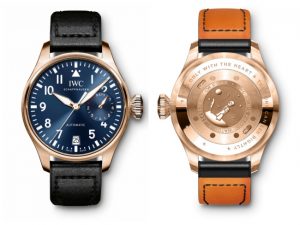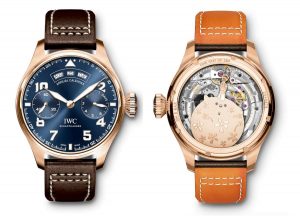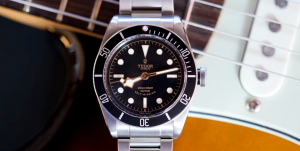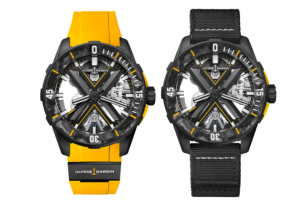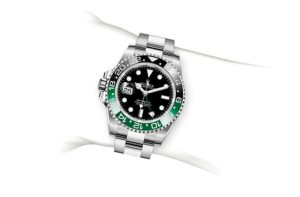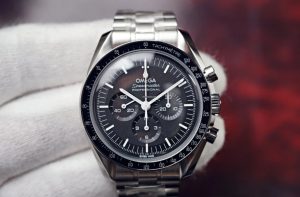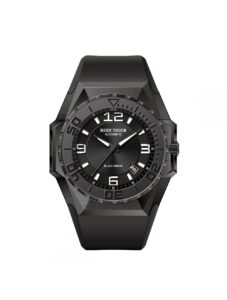
Things could be worse: a sunny summer day, a speedy convertible and a cool IWC watch. The car is the Mercedes SLS AMG Roadster. The watch is also an AMG, of sorts: the Ingenieur Automatic AMG Black Series Ceramic, introduced in 2013 in honor of IWC’s sponsorship of the Mercedes AMG Petronas Formula 1 team. It seems fitting that we test the AMG watch while test driving an AMG car, so here we are at AMG headquarters in Affalterbach, Germany, ready to take car and watch for a spin.
We spend the morning shooting photos of the watch in and around the parked roadster, so we have time to scrutinize all the IWC’s details.
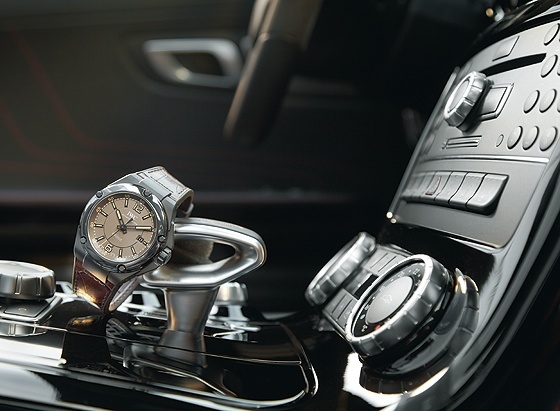
The metallic brown of the dial contrasts beautifully with the matte black ceramic case and the shiny black ceramic bezel, which look every bit as high-tech as the five eye-catching screws with special heads on the front of the watch. The warm color of the dial, the beige-orange luminous material on the indices and hands and the leather-inlay strap add a very special touch to this otherwise technical-looking watch – like a brown leather sofa in front of an exposed-concrete wall.
The SLS’s interior was designed in the same mode: the air vents and gear-selector lever are milled from aluminum and are inspired by jet engines and throttle controls. The rest of the interior boasts plenty of plush upholstery.
The watch’s indices are shaped like miniature racecars, with high tail-end spoilers on their outer ends.
Now it’s time for our test drive. The convertible top disappears behind the seats and a roaring eight-cylinder fanfare trumpets from the tailpipes when we press the start button. Wow! We forget all about the Ingenieur’s quiet ticking when we hear that. Even the 1,000-watt surround-sound system from Bang & Olufsen becomes a trifling matter, but we switch it on anyway.
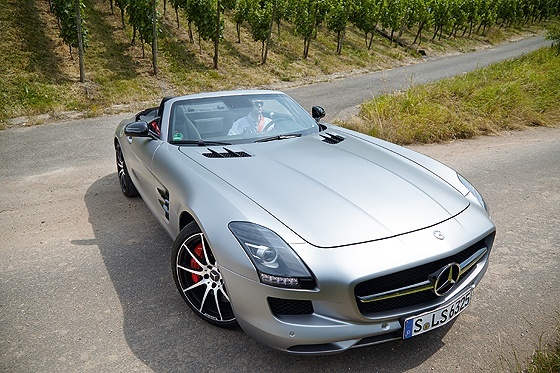
The SLS AMG is easy to drive: we simply shift the selector lever to “D” and enjoy a smooth and rather comfortably suspended ride both on straight stretches and around curves. The Ingenieur is equally user-friendly: the crown is easy to grasp, unscrew and pull out, despite the crown protectors. A stop-seconds hand and a rapid-reset mechanism for the date simplify exact setting.
At long last, we reach the autobahn, leaving speed limits behind. We press the pedal to the metal and the engine emits a sound like a jet taking off. The photographer, sitting in the passenger’s seat, clings anxiously to his camera. From zero to 60 in 3.7 seconds makes you feel as if you’ve just kicked a giant. The speedometer soon reaches 100 mph. Even at this speed, the wind blowing through our hair is more or less endurable. The photographer is no doubt relieved to discover there is too much traffic on the autobahn for us to safely accelerate to the car’s incredible top speed of 200 mph.

Of course, unlike cars, watches are judged not by how fast they go but by how precisely. After our ride, with the help of a timing machine, we find the Ingenieur to be precise indeed. With an average daily gain of just 1.8 seconds, the Ingenieur AMG comes quite close to achieving optimal performance. The greatest deviation among positions, six seconds, is more than acceptable. The amplitude of the balance is fairly stable between flat and hanging positions.
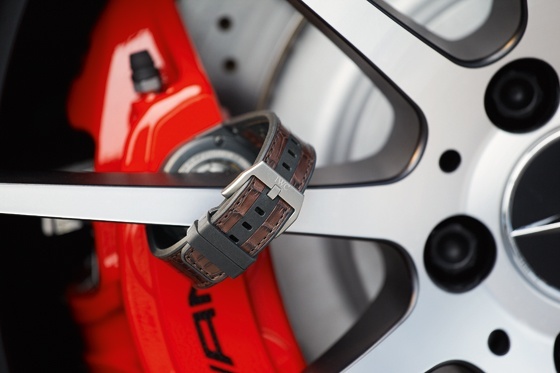
The Ingenieur’s dial is easy to read. The indices and the two numerals ensure adequate orientation and the double-digit minutes numerals on the flange above the hour indices are surprisingly helpful. You can tell the time quickly, even while you’re driving through a tunnel, although the dial’s luminosity weakens if the watch is in the dark for a long time.
At the moment, though, in the blazing sunshine, there’s no need to worry about luminosity. We’ve found the switch to operate the car’s adaptive adjustable suspension. We choose “sport plus” and steer through the curves at breakneck speed. The suspension in this setting is so hard that the Ingenieur is challenged to cushion the impacts with its serpentine rotor bridge, designed to absorb shocks. We’re also pleased that despite this watch’s diameter of 46 mm, its strap clings as closely and as comfortably to our wrist as does the racing seat of the SLS to its driver. Nothing presses uncomfortably against the wrist, and the strap’s rubber inner surface feels as soft and supple as the roadster’s Alcantara upholstery.

We pull over for a quick break in a shady spot, and this gives us a chance to take a closer look at the strap and clasp, where we discover a shortcoming, at least in warm weather: the seam wicks perspiration from the wrist to the strap’s prettily grained leather inlay, which causes the inlay to darken along its edges. The buckle is pronged and made of matte titanium rather than ceramic, but it’s nevertheless a good match for the watch. The buckle is easy to use and doesn’t feel unduly thick, thanks to the beveled slits in the strap.
The ceramic of the watch’s case has a hardness of 1,350 on the Vickers scale and is six times as scratch resistant as steel. On the other hand, it will break when subjected to just one-tenth as much force as would permanently deform steel. Shattered cases are nonetheless rare. The cases are made by Formatec Technical Ceramics of the Netherlands.
The movement is made in house. It’s the Caliber 80110, which IWC introduced at the time of the relaunch of the Ingenieur collection in 2005. It incorporates the Pellaton pawl winding system and Triovis fine adjustment. The movement is scantily embellished; the surfaces aren’t polished and the edges aren’t beveled.
The rotor on our test watch is blackened and various decorative patterns are available.
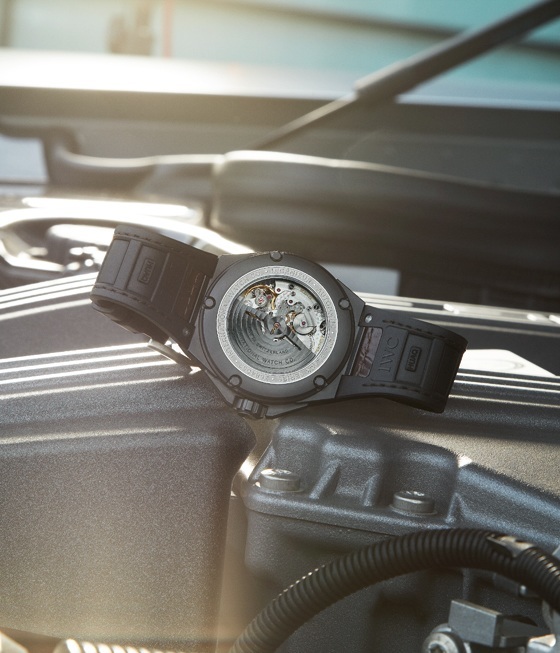
Unlike earlier Ingenieur models, this one does not incorporate a soft-iron Faraday cage to protect the movement from magnetic fields. Leaving it out enabled the designers to make the watch thinner and to incorporate a transparent back. Given the lack of protection, we were glad that the lateral loudspeakers of the SLS’s sound system are installed somewhat higher up, where the watch won’t come too close to them when you rest your forearm on the armrest.
The watch’s styling alludes to the Ingenieur SL by Gérald Genta from the 1970s, a sporty luxury watch with an integrated metal bracelet and five holes on its bezel. With the collection’s 2005 relaunch, the case took on a more angular shape and the numerals on the dial their current look. Crown protectors have been a familiar feature since 2009, when they appeared on the Ingenieur Mission Earth. The screws on the bezel, which replace the five holes, are new. They’re not merely decorative: they penetrate all the way through to affix the bezel and the back to the middle piece of the case. Their unusually shaped heads through to affix the bezel and the back to the middle piece of the case. Their unusually shaped heads are examples of the watch’s good craftsmanship.
Exclusiveness is important for both luxury cars and luxury watches. Pricing is one way to achieve it. Plan to spend $12,300 for the IWC Ingenieur Automatic AMG Black Series Ceramic, a sum about equal to the surcharge for the SLS’s optional ceramic brakes. This comparison is pretty much the only one that can make this watch seem like a bargain. One has a right to expect more embellishments in such a costly watch, especially on its movement. But who would talk about money when he’s cruising along in a superlative sports car and wearing a cool watch? If you can afford the SLS, we would recommend that you opt for the version without ceramic brakes, and use the money you save to buy the ceramic Ingenieur.
Sadly, the time has come to return the SLS, to electrically close its roof and hand over the keys. Our homeward journey in an old VW Passat brings us back to reality, but we’re consoled by knowing we’ll be able to wear the Ingenieur for a few more days.
